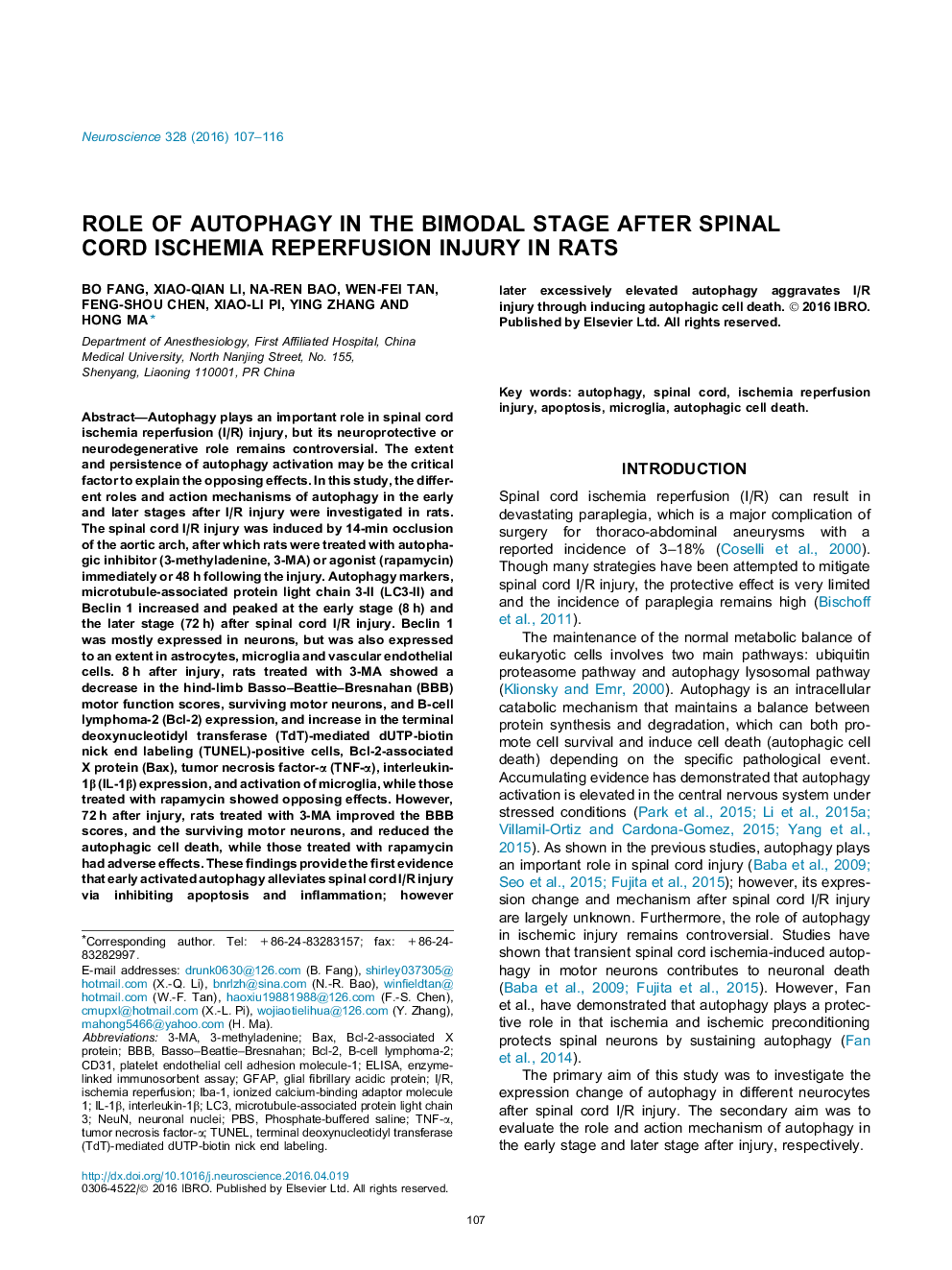| کد مقاله | کد نشریه | سال انتشار | مقاله انگلیسی | نسخه تمام متن |
|---|---|---|---|---|
| 6271126 | 1614748 | 2016 | 10 صفحه PDF | دانلود رایگان |
عنوان انگلیسی مقاله ISI
Role of autophagy in the bimodal stage after spinal cord ischemia reperfusion injury in rats
ترجمه فارسی عنوان
نقش اتوفایگی در مرحله دوزیستی پس از آسیب به بافت مجدد اگزمای نخاعی در موش صحرایی
دانلود مقاله + سفارش ترجمه
دانلود مقاله ISI انگلیسی
رایگان برای ایرانیان
کلمات کلیدی
NeuNPBSLC3IL-1βCD31GFAP3-MABcl-23-methyladenine - 3-متیل آدنینI/R - I / RIba-1 - IBA-1Ischemia reperfusion injury - آسیب مجدد ایسکمیAutophagy - اتوفاژیIschemia reperfusion - ایسکمی reperfusionInterleukin-1β - اینترلوکین-1βBasso–Beattie–Bresnahan - باسو بیتی برسنهانBax - باکسEnzyme-linked immunosorbent assay - تست الیزاELISA - تست الیزاtumor necrosis factor-α - تومور نکروز عامل αTUNEL - تونلApoptosis - خزان یاختهایmicrotubule-associated protein light chain 3 - زنجیره سبک پروتئینی مرتبط با میکروتوبول 3BBB - سد خونی مغزیSpinal cord - طناب نخاعیTNF-α - فاکتور نکروز توموری آلفاB-cell lymphoma-2 - لنفوم سلول B-2Phosphate-buffered saline - محلول نمک فسفات با خاصیت بافریAutophagic cell death - مرگ سلول اتوفاژیکionized calcium-binding adaptor molecule 1 - ملکول آداپتور اتصال دهنده کلسیم یونیزه 1platelet endothelial cell adhesion molecule-1 - مولکول چسبندگی سلول اندوتلیال پلاکتی-1Microglia - میکروگلیاهاneuronal nuclei - هسته های نورونیBcl-2-associated X protein - پروتئین X مرتبط با Bcl-2Glial fibrillary acidic protein - پروتئین اسیدی فیبریلاسیون گلایال
موضوعات مرتبط
علوم زیستی و بیوفناوری
علم عصب شناسی
علوم اعصاب (عمومی)
چکیده انگلیسی
Autophagy plays an important role in spinal cord ischemia reperfusion (I/R) injury, but its neuroprotective or neurodegenerative role remains controversial. The extent and persistence of autophagy activation may be the critical factor to explain the opposing effects. In this study, the different roles and action mechanisms of autophagy in the early and later stages after I/R injury were investigated in rats. The spinal cord I/R injury was induced by 14-min occlusion of the aortic arch, after which rats were treated with autophagic inhibitor (3-methyladenine, 3-MA) or agonist (rapamycin) immediately or 48 h following the injury. Autophagy markers, microtubule-associated protein light chain 3-II (LC3-II) and Beclin 1 increased and peaked at the early stage (8 h) and the later stage (72 h) after spinal cord I/R injury. Beclin 1 was mostly expressed in neurons, but was also expressed to an extent in astrocytes, microglia and vascular endothelial cells. 8 h after injury, rats treated with 3-MA showed a decrease in the hind-limb Basso-Beattie-Bresnahan (BBB) motor function scores, surviving motor neurons, and B-cell lymphoma-2 (Bcl-2) expression, and increase in the terminal deoxynucleotidyl transferase (TdT)-mediated dUTP-biotin nick end labeling (TUNEL)-positive cells, Bcl-2-associated X protein (Bax), tumor necrosis factor-α (TNF-α), interleukin-1β (IL-1β) expression, and activation of microglia, while those treated with rapamycin showed opposing effects. However, 72 h after injury, rats treated with 3-MA improved the BBB scores, and the surviving motor neurons, and reduced the autophagic cell death, while those treated with rapamycin had adverse effects. These findings provide the first evidence that early activated autophagy alleviates spinal cord I/R injury via inhibiting apoptosis and inflammation; however later excessively elevated autophagy aggravates I/R injury through inducing autophagic cell death.
ناشر
Database: Elsevier - ScienceDirect (ساینس دایرکت)
Journal: Neuroscience - Volume 328, 22 July 2016, Pages 107-116
Journal: Neuroscience - Volume 328, 22 July 2016, Pages 107-116
نویسندگان
Bo Fang, Xiao-Qian Li, Na-Ren Bao, Wen-Fei Tan, Feng-Shou Chen, Xiao-Li Pi, Ying Zhang, Hong Ma,
